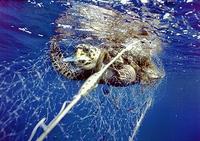 根據一項全球首次針對意外捕獲海龜的研究指出,過去20年來,已經有數以百萬計的海龜因為誤入漁網或者是被延繩釣勾住而死亡。
根據一項全球首次針對意外捕獲海龜的研究指出,過去20年來,已經有數以百萬計的海龜因為誤入漁網或者是被延繩釣勾住而死亡。
捕捉到非目標物種的情形稱之為「混獲」,發生在使用漁網或者是有數千個釣餌魚鉤的延繩釣時,造成其他物種死亡的狀況。
混獲的結果造成全世界7種海龜中的6種,被列入了國際自然保育聯盟(IUCN)紅皮書中的易危(VU)、瀕危(EN)以及極危(CR)等級。
這些海龜分別是:赤蠵龜、革龜、玳瑁、欖蠵龜、肯氏龜與綠蠵龜。至於第七種海龜──澳洲特有種平背龜,則由於缺乏足夠資料,目前無法確認族群的狀態。
研究指出,(在演化的角度來看)據信這些古老的物種,在1億1千萬年前就已經與從其他龜類分支出來了,但現在卻受到不負責任的捕撈方式而瀕臨滅絕。
這篇發表在本周出版的《自然保育通信》期刊(Conservation Letters)的研究報告,是由保育國際(Conservation International)與杜克大學(Duke University)的全球計劃(Project GloBAL)共同合作,旨在評估全球長壽物種的混獲狀況。
研究中說明了當海龜遇到三種不同漁具時的下場,分別是刺網、延繩釣以及拖網。海龜是呼吸空氣的爬蟲類,往往因為溺斃或是吞下尖銳的J型魚鉤而死亡。隨種類的不同,海龜的自然壽命通常可達50至100年以上。
在這篇名為《全球海龜混獲模式》的報告中,保育國際的華萊士博士(Dr. Bryan Wallace)與聖地亞哥州立大學的劉易森博士(Dr. Rebecca Lewison)以及幾位來自杜克大學海洋保育中心的同事,研究了1990年至2008年間,全球海龜受到混獲的影響。
研究中回顧的資料顯示,過去20年間有85,000隻海龜被混獲,但華萊士與他的同事們強調,實際上海龜因混獲而死亡的數字「可能遠大於此」。
海龜每年旅行數千公里,橫跨大洋之間的繁殖地與覓食場。其生存所受到的威脅有:為了海龜肉的捕捉、龜蛋的採集、產卵沙灘受到破壞、海洋污染以及氣候變遷。但研究人員發現,混獲是最大的問題,嚴重威脅所有的海龜族群。
在混獲率方面,延繩釣混獲率最高的地區是墨西哥的下加利福尼亞半島,刺網混獲率最高的地區是地中海的北亞得里亞海地區,至於拖網則在是烏拉圭外海。當綜合比較分析混獲率以及三種不同漁具的作業方式時,發現了四個極需要優先保育的地區,分別是:地中海、東太平洋、西南大西洋、西北大西洋。
地中海地區有20多個國家在此捕撈高價值的黑鮪魚以及旗魚,由於缺乏綜合管理機制,導致此地有全球最高的延繩釣與拖網作業密度,也有最高的海龜混獲率。
至於東太平洋墨西哥的下加利福尼亞州到智利的巴塔哥尼亞,革龜與玳瑁的族群量已幾乎崩潰。華萊士與他的研究團隊指出,族群量崩潰的原因是在公海與近海中,各大小漁業規模中所大量使用的延繩釣、刺網以及蝦拖網所造成的混獲。
「我們才剛剛開始觸及海龜混獲現實問題的表面,」華萊士博士說。「我們的研究顯示,在一些從事小型規模漁業的地區中還有一些重要的數據缺口,特別是非洲東部、印度洋和東南亞地區。對這些地區最迫切的優先事項是加強監測與回報工作,以便我們能夠填補那些海龜混獲資料的空白處。」
為了降低海龜的混獲率,並提高海洋的整體健康,保育國際的全球海洋部門建議成立海洋保護區、執行船隻監測系統與隨船觀察員計畫。
保育國際同時建議永續漁業的改革,包括季節性與時間性的區域禁漁,以限制在海龜遷徙區的漁業活動,同時施行漁獲總量管制-限制漁獲量並減少捕魚競爭。
另外也要修改漁具,擴大使用圓鉤來取代高殺傷性的J型鉤,並且推廣海龜脫逃裝置(Tuetle Excluder Devices, TED),此裝置的作用是當海龜陷入蝦拖網時,有一出口可以逃脫。這些準則也被聯合國糧農組織所推薦。
Millions of sea turtles are thought to have died over the past 20 years because they were caught accidentally in fishing nets or snagged on longlines, according to the first ever global study of unintended capture on marine turtle populations.
Unintended capture of non-target species, called bycatch, happens when fisheries use gear such as longlines with thousands of baited hooks, or nets that kill animals other than those they are intended to catch.
As a result, six of the world's seven species of marine turtles now are categorized as Vulnerable, Endangered, or Critically Endangered on the authoritative Red List of Threatened Species complied by the International Union for the Conservation of Nature, IUCN.
They are loggerheads, leatherbacks, hawksbills, olive ridleys, Kemp's Ridleys and green sea turtles. The conservation status of the seventh marine turtle species, the flatback, endemic to Australia, is currently unclear due to lack of data.
These ancient species, believed to have become distinct from all other turtles at least 110 million years ago, are now being wiped out by irresponsible fishing practices, the study shows.
Published this week in the journal "Conservation Letters," the research was conducted by Conservation International in partnership with Duke University's Project GloBAL, which stands for Global By-catch Assessment of Long-lived Species.
It documents what happens to marine turtles when they encounter the three major types of fishing gear - gillnets, longlines, and trawls. Air-breathing reptiles, sea turtles often perish as a result of drowning in nets or swallowing sharp J-shaped hooks, while their natural life spans range from 50 to more than 100 years, depending on species.
In their report titled "Global Patterns of Marine Turtle Bycatch," Dr. Bryan Wallace of Conservation International and Dr. Rebecca Lewison of San Diego State University, with several co-authors from Duke University's Center for Marine Conservation, investigated the impact of bycatch on sea turtles around the globe from 1990-2008.
Their global data review shows that some 85,000 marine turtles have been reported as bycatch in the past 20 years, but Wallace and colleagues stress that the actual numbers of sea turtles killed as bycatch are "likely to be significantly higher."
Sea turtles migrate across vast areas of ocean between nesting and feeding grounds, traveling thousands of miles each year. Their survival is threatened by capture for their meat and collection of eggs, destruction of nesting beaches, pollution of the ocean, and climate change. Yet the researchers found that bycatch is the most serious, acute threat to all sea turtle populations.
The highest reported bycatch rates for longline fisheries occurred off Mexico's Baja California peninsula, the highest rates for gillnet fishing took place in the North Adriatic region of the Mediterranean and the highest rates for trawls were found off the coast of Uruguay.
When bycatch rates and fishing activity for all three fishing gear types were combined and compared, four regions emerged as the most urgent conservation priorities - the Mediterranean, the Eastern Pacific, the Southwest Atlantic, and the Northwest Atlantic.
In the Mediterranean Sea, where more than 20 countries fish for lucrative species like bluefin tuna and swordfish, a lack of integrated management has led to some of the world's highest concentrations of longline fishing and trawling, and some of the highest sea turtle bycatch rates.
In the Eastern Pacific, from Baja California to Patagonia, Chile populations of leatherback and hawksbill turtles have nearly collapsed. Wallace and his team say the collapse is due in part to bycatch in large and small-scale fisheries which deploy large numbers of longlines, gillnets and shrimp trawls on the high seas and also near shore.
"We have only begun to scratch the surface about the realities of sea turtle bycatch," said Dr. Wallace. "Our review revealed important data gaps in areas where small-scale fisheries operate, especially Africa, the eastern Indian Ocean and Southeast Asia. These regions and fisheries are urgent priorities for enhanced monitoring and reporting effort so that we can fill in some blanks about turtle bycatch."
To lower sea turtle bycatch rates, and improve overall ocean health, Conservation International's Global Marine Division recommends establishing Marine Protected Areas, a vessel monitoring system and on-board observer programs.
Conservation International also recommends sustainable fisheries reform, including seasonal and time-area closures to control fishing activity in turtle migration areas as well as catch-shares, which place quotas on fishing efforts and reduce the race for fish.
Gear modification to replace damaging J-hooks with the expanded use of circle hooks, as well as the widespread implementation of Turtle Excluder Devices, which serve as escape hatches for sea turtles caught in shrimp trawls. These guidelines are also recommended by the UN Food and Agriculture Organization.




